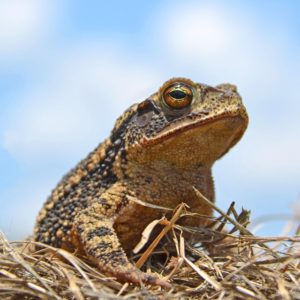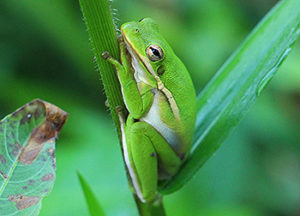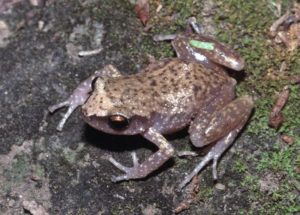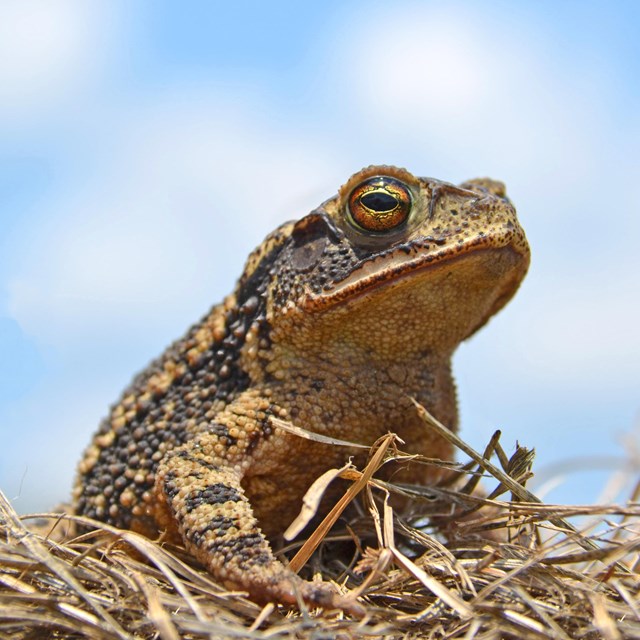The warm weather of summer brings out all kinds of creatures that had remained hidden during the cooler months. One such group of animals, that has recently become active, are frogs. A lot of people think that you need to visit a pond or a stream or a marsh to see frogs, but they are right here, all around Houston. We can see many species of frog right in our own backyards. Let’s have a look at a few species that are most commonly encountered.
 The Gulf Coast Toad is the most common frog found in yards around the Houston area. As with most toads, they are primarily terrestrial, only heading to bodies of water and rain puddles to drink, mate, and lay eggs. They have bumpy skin, but those bumps aren’t warts, not like the kind that we get on our hands or feet (those are caused by a virus passed between people). Toads do have, however, poison glands on the sides of the head which produce a milky toxin, that helps protect them from predators. After heavy rains, listen for a loud trill call from ditches, ponds, and wetlands.
The Gulf Coast Toad is the most common frog found in yards around the Houston area. As with most toads, they are primarily terrestrial, only heading to bodies of water and rain puddles to drink, mate, and lay eggs. They have bumpy skin, but those bumps aren’t warts, not like the kind that we get on our hands or feet (those are caused by a virus passed between people). Toads do have, however, poison glands on the sides of the head which produce a milky toxin, that helps protect them from predators. After heavy rains, listen for a loud trill call from ditches, ponds, and wetlands.
The Green Treefrog, despite its name, is found in wet areas away from trees, even in  gardens on the sides of houses. This large bright green, waxy looking tree frog, is active on warm summer nights, when it can sometimes be heard making a loud nasal KWAK KWAK KWAK call. In wetlands, the chorus of dozens and dozens of males may be deafening. As with that vast majority of frogs, it is the males that call, to attract females to mate. Also, as with most frogs, they require standing water to lay their eggs. There is a similar small treefrog that can be either green or brown, called the squirrel treefrog, that you may encounter around your house as well.
gardens on the sides of houses. This large bright green, waxy looking tree frog, is active on warm summer nights, when it can sometimes be heard making a loud nasal KWAK KWAK KWAK call. In wetlands, the chorus of dozens and dozens of males may be deafening. As with that vast majority of frogs, it is the males that call, to attract females to mate. Also, as with most frogs, they require standing water to lay their eggs. There is a similar small treefrog that can be either green or brown, called the squirrel treefrog, that you may encounter around your house as well.
 Rio Grande Valley Chirping Frogs were introduced into the Houston area accidentally in potted plants brought up from the Valley. The Lower Rio Grande Valley of Texas is the Northernmost extent of their native range, the area around Brownsville and Harlingen. Chirping frogs do not require standing water to lay their eggs, so they lay them in moist soil. Their offspring go through the tadpole stage inside of the egg. Basically, the conditions in the soil of a potted plant, and in the leaf litter of your garden are ideal. Though you may not see these tiny frogs often, you will hear them squeaking and chirping after rains, next to your home.
Rio Grande Valley Chirping Frogs were introduced into the Houston area accidentally in potted plants brought up from the Valley. The Lower Rio Grande Valley of Texas is the Northernmost extent of their native range, the area around Brownsville and Harlingen. Chirping frogs do not require standing water to lay their eggs, so they lay them in moist soil. Their offspring go through the tadpole stage inside of the egg. Basically, the conditions in the soil of a potted plant, and in the leaf litter of your garden are ideal. Though you may not see these tiny frogs often, you will hear them squeaking and chirping after rains, next to your home.
If you want to encourage some of these frogs to live in your yard, you need to make your yard and garden a good habitat for them. Try not to use chemical fertilizers and pesticides. Make sure to leave leaf litter under bushes and other plants. Try to have a variety of native plants that will attract tasty insects. If you have space for it, try to have a small pond that frogs can soak in.



